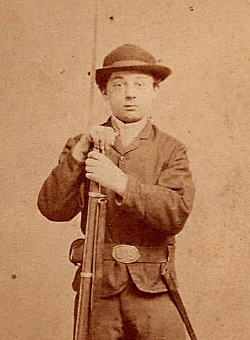
Please send all Checks and Money orders to :
Dave Taylor P.O. Box 87 Sylvania, OH 43560
419-842-1863
Click Here to E-mail Us!
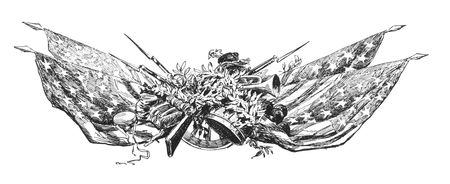
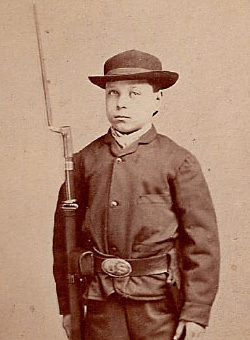
17-10-01

17-10-01… IDENTIFIED AMES USN 1852 PATTERN OFFICER’S SABER … Light rayskin or sharkskin grip with the twisted wire binding. Nicely detailed brass hilt with muted gilding remaining on much of it. Minty blade, with very visible blade etching and most of the original factory luster. It is etched with the Ames company name and address etched just above the ricasso and a mix of patriotic and military motifs including an anchor and “USN” in a scroll on one side and the officer’s name “A.D. Baird” on the other. Brass mounted leather scabbard in superb condition with typical Ames heavy navy mounts with ropes figures into the carry ring mounts and a sea serpent curled around the drag. The blade on this is certainly wide enough to fit typical Civil War dimensions and the officer’s name could not be clearer, but we are at a dead-end in identifying him. We have searched every USN officer named A D Baird from the Civil War through the early 1900s without luck. He does not show up in the USN rosters. Our best guess is that he is a volunteer officer or perhaps a contract surgeon or a Revenue Service officer or ???. In any case, this is an exceptional sword with vivid etching in great condition that displays very well. With information being added daily to the web it might still be possible to identify the owner in the near future. A real looker … $1,750.00
Call us @ 419-842-1863

17-10-02… RARE, RARE, RARE MICHIGAN CAVALRY LINDNER CARBINE! … Flayderman does not even list this early “true first pattern” Lindner- you have to go to Reilly’s U.S. Military Small Arms to even find it! Lindner patented a breechloading system similar to Hall’s: a breech block is hinged at the rear and opened by a spring when a forward rotating collar is rotated by a flat handle, allowing the paper cartridge to be inserted from the front. Any Lindner is scarce, but the ones we usually see are the so-called first and second type. Everyone agrees the “second type” did not see service here, and Flayderman thought his “first type” was the one supplied under a contract of November, 1861, and issued to the 1st Michigan Cavalry, and in 1863 to the 8th West Virginia Mounted Infantry. Recent scholarship, however, shows the Michigan Cavalry actually got about 400 Lindner conversions of Austrian carbines, which is exactly what we have here. It is the first such specimen I have personally encountered, and it came out of an old Michigan collection. Ours shows typical light colored Austrian wood, iron buttplate, sideplate and triggerguard, with brass stock screw escutcheon, flat band retaining spring for the rear of the loading chamber, collar for the front of the receiver and single strap barrel band and front sight. No lockplate markings are visible, but there are some small assembly numbers present, and the Lindner serial number 237 is stamped at the left breech. Also visible is part of the three-line Lindner patent marking on the top of the breech near the bolster. “MAR” is fully legible, which would be the beginning of the third line: “EDWARD LINDER’S/PATENT/MARCH 29, 1859.” The left side of the stock mounts an iron sling ring on a short bracket. The mechanics are good. The wood has just minor handling marks and the metal is smooth, a mix of gray with subdued bright metal and scattered dark gray spots. Just a little light peppering near the nipple from firing. The sling swivel in the butt was removed long ago and the spot filled in with wood (see illus.) There is a lot more research to be done on these carbines, but they have a clear association with the First Michigan Cavalry, which has a tremendous combat record and ended up commanded by Custer in the Michigan Cavalry Brigade. They suffered some 14 officers and 150 enlisted men killed in action or mortally wounded, an indication of their hard service. While they were armed with Burnside and Sharps carbines by the time of Gettysburg, they had an extremely active service record in Virginia serving under Banks and Pope. By CWdata’s count they had already been in more than 40 fights and skirmishes where they lost men by the beginning of 1863. I never use the phrase, “one chance in a life time,” but you won’t easily find another of these in any condition. One of the rarest Civil War guns North or South… $2,850.00
Sold
Call us @ 419-842-1863
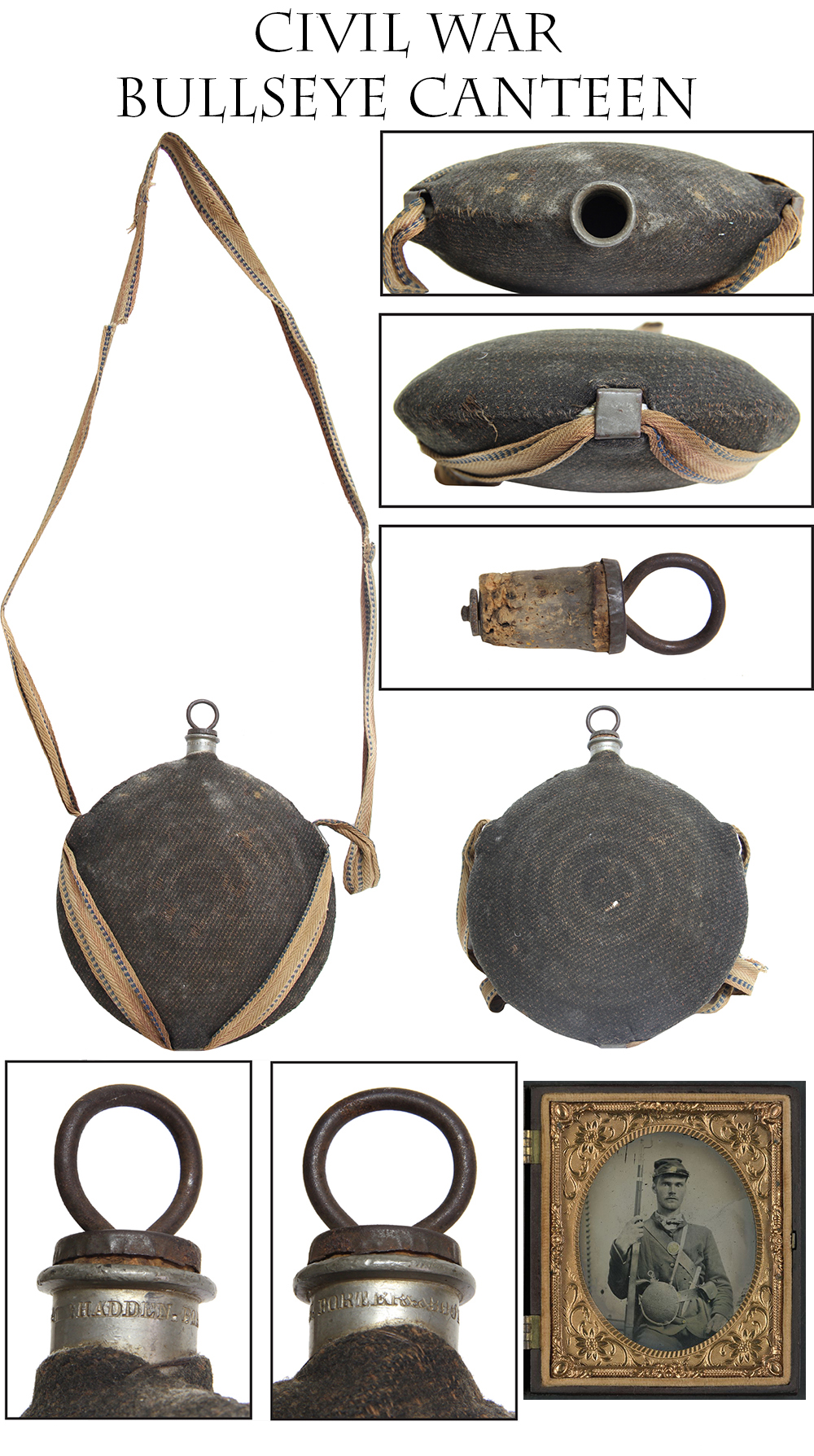
17-10-03… OUTSTANDING CIVIL WAR BULLSEYE CANTEEN … Full, dark blue cover with original sling. These corrugated canteens were considered an improved, sturdier version of the 1858 pattern US canteen and were supplied by many contractors during the war. None were made prior to the war and none were made after. All are wartime production canteens. This one bears a clear, Hayden, Porter and Booth stamp on the neck. The stopper is present. The cover has some minor discoloration stains near the top, but nothing unsightly and just enough to show it was used. The cover is tight, with no seam openings, has just one small moth nip or wear spot near the highpoint on the center on one side. The sling is original, complete, full length, and visually pleasing with blue side marks woven in and a faint reddish center stripe. There are a couple of spots of edge wear, one partial tear, and one overlapped spot where a tear was likely mended, likely from from hanging on a peg, but none of these detract from the overall appearance. Dark blue covered canteens have always been tough to find and a favorite of collectors. This one is a dandy. $595.00
Sold
Call us @ 419-842-1863

17-10-04… EARLY TRANSITION REVOLVER ca. 1845… These early bar-hammer revolvers have a certain elegance all their own. Plainly showing their connection to the early pepperbox style pistols that rotated all the integral barrels for the next shot with a hefty pull of the trigger, this “transition” style uses instead a rotating cylinder with six chambers and single barrel, like the conventional later revolvers. It maintains the double action, bar hammer design of the pepperbox. It is the mechanical transition from pepperbox to standard revolver, hence the name. English made. The only marking I can find is “Imp’d” on barrel flat, which likely stands for “Improved.” British proofs on cylinder. Over a foot long with six inch barrel. Roughly .44 caliber. The metal is smooth overall and silver-gray mixed with some plum brown. The hammer, side plates, upper and lower backstrap, and triggerguard are all nicely engraved with floral motifs, as is the flat buttplate cap. The grips are completely checkered with fine cross-hatching. The front sight is German silver, as is the diamond-shaped screw escutcheon on the grips. This is a very classy transitional revolver. Functions and indexes on a hit and miss basis only. A lot of gun for very little money. $595.00
Sold
Call us @ 419-842-1863

17-10-05… TWO PIECE U.S. INTERLOCKING BUCKLE ….These interlocking US buckles were introduced in 1839 and are mostly known as the enlisted artillery belt plate for both foot and mounted artillery sword belts of the Mexican War. They were also used by infantry sergeants as well with the old style short sword from 1839 to 1840, until the new 1840 pattern NCO swords and belts could be issued. A number of artillerymen also saw service as infantry during the period. This one has a nice medium patina and fits together perfectly, the outer and inner portions having been together forever. Technically replaced in Federal service by the 1851 pattern sword belt plates, many of these remained in service well into the Civil War. These are quite commonly found on the white buff short sword belts. Rarely do they turn up “loose”. $395.00
Sold
Call us @ 419-842-1863
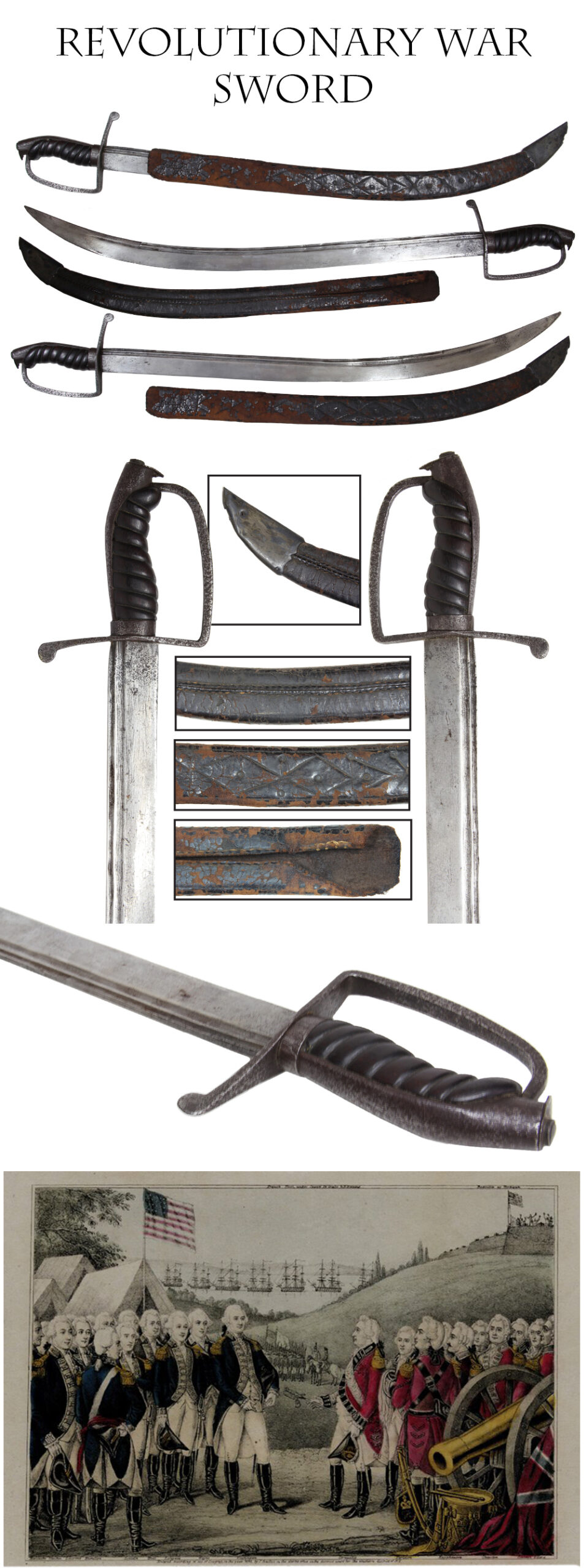
17-10-06… AMERICAN REVOLUTIONARY WAR SWORD / HANGER / SHORT SABER …A very American version of the hussar type light cavalry saber that came into popularity during the war, but shorter like a hanger. Iron hilted, stirrup grip with an awkward S-shaped grip and flat tear-drop pommel cap that actually extends above the knuckleguard. Iron backstrap and ferrule with a tall quillon. Leather wrapped grip with uneven ridges and grooves, bound with a single strand of wire, now missing. Blade has two narrow, shallow fullers along the back edge, extending part way along the characteristically sudden, upswept point or “American curve” as Neumann calls it. This upswept blade tip is classic Colonial American and shows the smith was not fully in control of the blade-tempering process, but could make a very functional edged weapon. Such tips are not found on European swords of the period as those smiths had solved the tempering issues generations earlier. The blade is smooth and silver gray with just some dark spots and shallow pitting near the guard and no edge nicks. The iron of the guard and pommel shows more exposure and light pitting. Remarkably, this saber still has its original tooled black leather scabbard with its iron drag still in place. The scabbard preserves about 65 or 70 percent of its finish and shows clearly its tooled design of X’s and dots. The scabbard is pretty solid, but does have the back seam open for a couple of inches and is missing the upper three inches or so that probably held a small button to secure it in a shoulder belt. A very scarce, very American, Revolutionary War saber priced like a common factory produced Civil War staff officers sword. The Real Deal… $2,250.00
Sold
Call us @ 419-842-1863
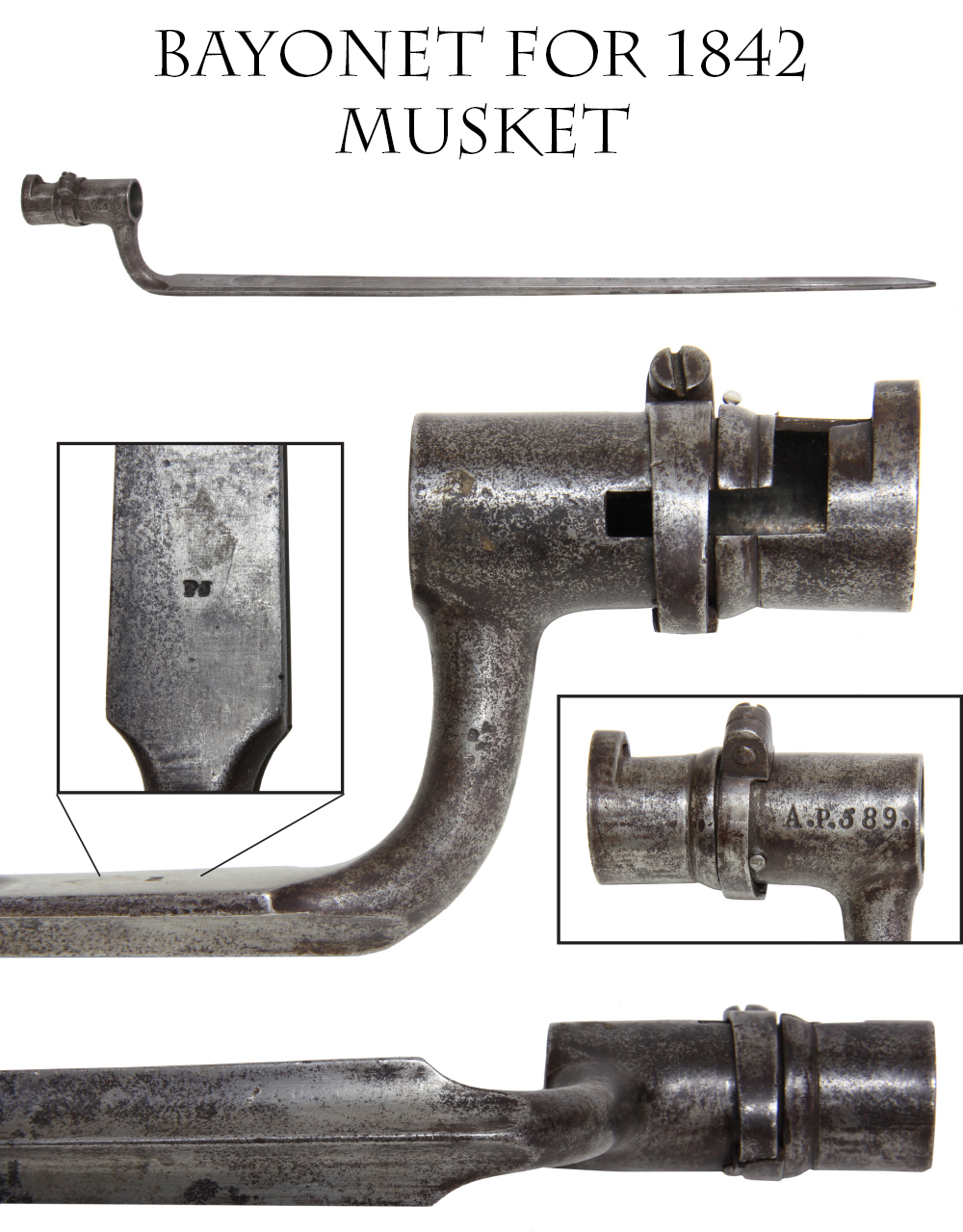
17-10-07… IMPORT FRENCH? PATTERN 1842 BAYONET: The U.S. imported thousands of European muskets to arm early war volunteers and many of these were .69 caliber arms with bottom-stud mounted socket bayonets. For details, consult Noe and Sebaroli, European Bayonets of the American Civil War. Small crown over two letters stamped on the neck. Small “PJ” blade maker’s stamp on the top of the blade near the base and a rack number stamped lengthwise on the socket. Fits a French P1842 musket and US 1842 as well. Price $135.00
Sold
Call us @ 419-842-1863

17-10-08…. Incredibly Rare Cincinnati Ohio Bahn Frei Bowie Knife … A rough condition but very rare Bowie knife from the period 1845 to 1860. This style of hilt is well known on the Cinti., Ohio made saber bayonets intended for Turner rifles. The Turners were German Americans who formed formal shooting clubs in the U.S. Many were in Cincinnati. Much rarer than the bayonet is this Bowie knife. It is constructed identically to the bayonets but is clearly a Bowie knife with no provision for attaching to a gun. A truly “bad-ass” Bowie knife with a vicious clipped point. The blade measures just under 11 inches long. Overall length is just under 16 inches. It is wonderfully formed with a curved false edge leading back 3+ inches from the tip. Condition is solid, but the cutting edge is chewed up and thin from corrosion. There is heavy corrosion on the back third of the blade, more evident on the right than the left, but the knife is solid and untouched. If you want a real Civil War period clip point Bowie that has not been assembled in someone’s basement during the last forty years, this is a hell of a knife. To put things in perspective… there are likely a hundred or so of the bayonets in existence. There are likely less than a dozen of these knives. The bayonets in scabbards bring around $3000 each. Not mint, but solid and striking. About as cool a knife as I have found $850.00
Sold
Call us @ 419-842-1863

17-10-09… EARLY PRODUCTION POND REVOLVER … Pre-lawsuit Pond belt revolver with long six inch barrel.. Six-shot .32 caliber rimfire revolver. Made from about 1861 to 1870, these revolvers infringed on the Rollin White patent held by Smith and Wesson, who sued Pond and won. The revolvers remaining in stock were then given Smith and Wesson markings as well. This one shows only the Pond markings, which are crisp, on the top flat of the barrel. Definitely a CW production weapon. Nice metal, smooth and mixed dull silver and gray. Good action and mechanics. Extremely nice grips with the brass-headed screwdriver still in place in the butt cap. Matching serial number 888. Flayderman estimated production at several thousand, but some 4,486 were still at the plant and marked for Smith and Wesson, so there can’t be that many with the original Pond markings alone. A very clean example of a commercially available Civil War side arm. $735.00
Sold
Call us @ 419-842-1863

17-10-10.. FINE CONDITION RIFLED AND SIGHTED 1842 SPRINGFIELD … Nice 1853, dated Springfield that was later rifled and sighted for use with the Minie ammunition that came into use with the 1855 series of arms. Extremely nice wood that has been gently cleaned. Shows sharp edges and the remains of an ink cartouche on the offside. The metal has also been carefully cleaned to bright, this was very well done. The 1853 dated lock markings are clear with just a little rubbing to the upper right of the eagle. The V/P/eagle barrel proofs are sharp and the 1855 barrel date is crisp, with just a little rubbing along the bottom. The mechanics are good, and all bands, springs and swivels are in place, as is the rod. The long-range rear sight is in place with leaves and elevator. The upper portion of the butt next to the buttplate tang bears an old unit stamp “M” over “WG,” the last probably being the abbreviation for a militia regiment,.. the “W-something Guards” most likely. Washington Guards, Waco Guards, etc… The buttplate itself bears a rack number, 276, as well as the correct US stamp. All in all, this is a great looking ’42, with a nice early date, showing the scarce rifled modifications made by the armories to bring these guns up to modern standards just before the outbreak of the Civil War. I had a hard time not pricing this higher… $1,950.00
Sold
Call us @ 419-842-1863
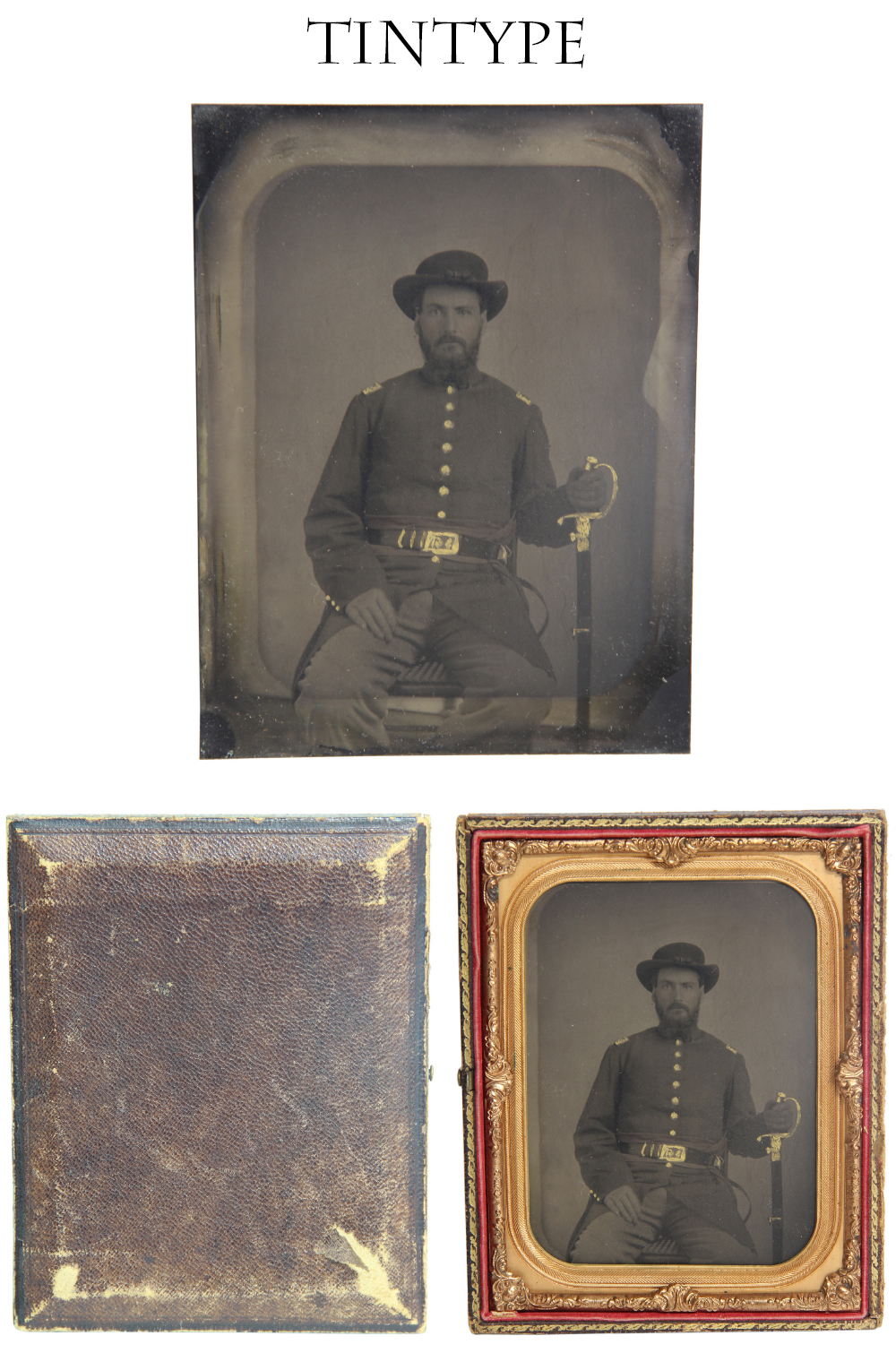
17-10-11… RARE HALF PLATE TINTYPE OF A YANKER INFANTRY OFFICER … Finding these large half plate images is a rare event. Measures 6 x 4.75 inches including the case. 5.5 x 4.25 inches image alone. Three-quarter length seated tintype of Yankee infantry line officer. A very clear view. Our man wears the regulation single-breasted frock coat of a lieutenant or captain, along with a non-regulation narrow brimmed hat. He also holds his 1850 pattern foot officer’s sword up and out to one side for the camera. Brass details like his buttons, belt plate and sword hilt have been gilded by the photographer, obscuring a few details, but not intruding overly on the composition of the photo. Aware that tintypes reverse the image of the subject, our man has flipped his sword belt upside down to bring the slings over to the other side, but then detached them anyway from the sword so that he could show it off better to the camera. Complete with glass, mat and frame in a leatherette case, complete, but separated along the hinge. It was likely a cherished memento at home. We can only wonder if he made it back. Half Plate ! $595.00
Sold
Call us @ 419-842-1863
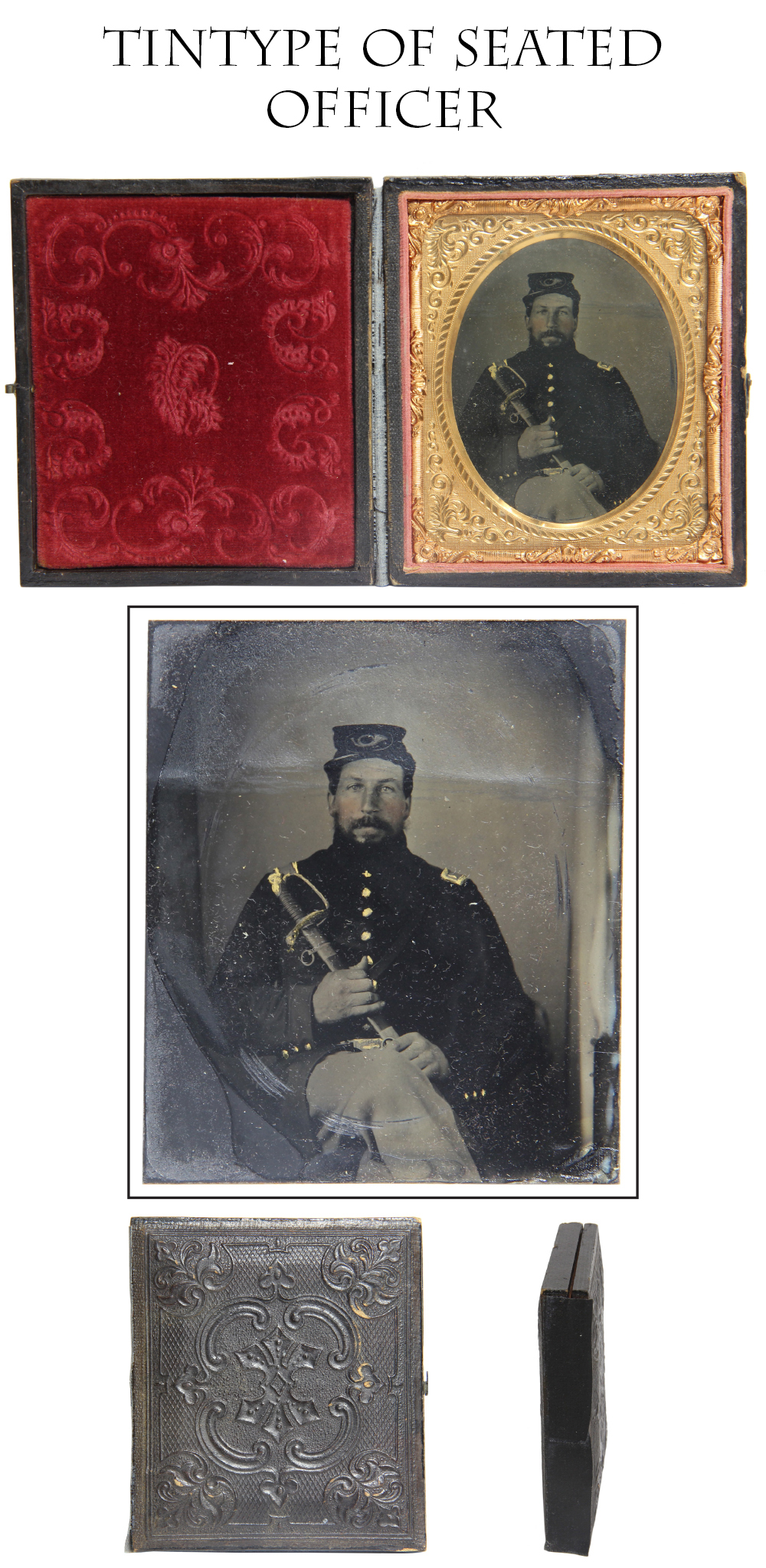
17-10-12… YANKEE OFFICER CRADLES HIS SWORD FOR THE FOLKS BACK HOME … Sixth plate tintype of a Yankee line officer. A very clear view. Some solarization around the edges that is hidden by the oval mat. Our man wears a commercial forage cap with an officer’s large embroidered infantry horn insignia on the front. 2/3 view, knees up. Some brass elements are lightly gilded, but not obtrusively so. He holds up his officer’s sword to show off to the camera and his shoulder straps seem to show the single bar of a first lieutenant. His cheeks are lightly tinted. A nice clear image of a Yankee line officer who fought on the front line with his company. Complete with mat, glass, frame and leatherette case. There is a modern slip of paper identifying him as Michael D. Miller. $225.00
Sold
Call us @ 419-842-1863
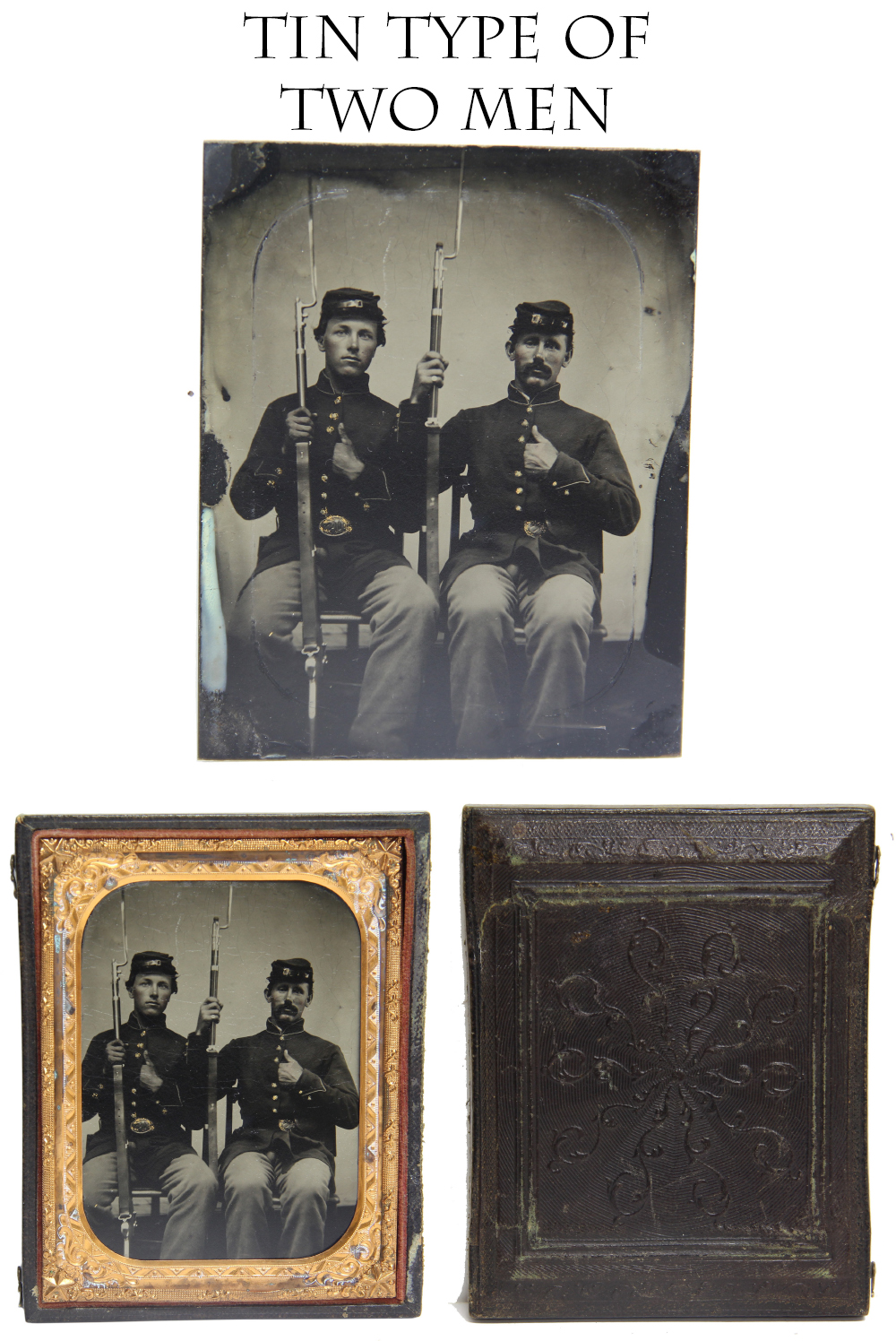
17-10-13… TINTYPE OF TWO ARMED UNION INFANTRYMEN A wonderful large quarter plate cased tintype with glass, mat and frame and bottom half of case. Wonderful clarity and detail. These two pards wear regulation infantry enlisted men’s frock coats and forage caps. Each adopts a Napoleonic hand-in-breast pose while seated for the camera. Both are posed with their rifle muskets, which appear to be 1861 patterns, with slings mounted and bayonets fixed. The fellow on the right has even left his muzzle tompion in place for the camera. Three-quarter length seated view. The photographer lightly rouged their cheeks and slightly gilded the buttons and plates, but the US is plainly visible on each man’s belt plate. A little discoloration to the brass mat under the glass is inconsequential. This is a nice, strong image with good weapons content. These two men represent the basic fighting men of the Civil War. $495.00
Sold
Call us @ 419-842-1863

17-10-14…TINTYPE OF A UNION ARMY DRUMMER WITH HIS DRUM … Excellent, clear, sixth plate size, full-standing tintype of a Civil War Union drummer, posed holding his drum at his side in front of a painted backdrop showing a large fort with flag overlooking a stream and countryside. Our man wears a regulation forage cap and enlisted frock coat, and holds a drum at his side to indicate he is a company musician. We often think of drummers strictly as boys, but in point of fact most drummers and other musicians in the Civil War were adults. Our hero has buckled on an officer’s belt and sword, perhaps lent to him by his company commander waiting in the wings for his turn in front of the camera. Buttons, sword hilt and belt plate lightly gilded, but delicately so. Full leatherette case with mat and glass, hinge split. Great clarity, very rare content, and a wonderful studio backdrop. $695.00
Sold
Call us @ 419-842-1863
Layaways are Welcome
Need to split your order into multiple payments? No problem! A simple 20% earnest money deposit will hold your item for you.-acf
You can then pay it off in easy installments that fit your budget.
Read Terms Here
Items to Sell? Contact Us
I am always interested in buying ANYTHING from the American Civil War… Guns, Swords, Civil War Muskets, Knives, Uniforms, Flags, Medals, Badges, Diaries, Letters, Autographs, Buttons, photographs, tintypes, daguerreotypes, Insignia, Camp Items, Battlefield Relics, canteens, Drums, Etc… Call 419-842-1863 and ask for Dave Taylor.

